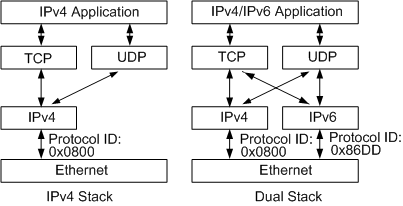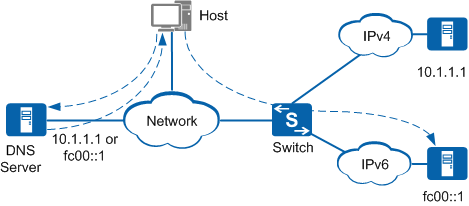Dual Protocol Stack
Dual protocol stack is a technology used for the transition from the IPv4 to IPv6 network. Nodes on a dual stack network support both IPv4 and IPv6 protocol stacks. A source node and a destination node use the same protocol stack. Network devices use protocol stacks to process and forward packets based on the protocol type of packets. You can implement a dual protocol stack on a unique device or a dual stack backbone network. On the dual stack backbone network, all devices must support both IPv4 and IPv6 protocol stacks. Interfaces connecting to the dual stack network must be configured with both IPv4 and IPv6 addresses. Figure 1 shows the structures of an IPv4 stack and a dual protocol stack.
A dual protocol stack has the following advantages:
Supported by multiple link protocols.
Multiple link protocols, such as Ethernet, support dual protocol stacks. In Figure 1, the link protocol is Ethernet. In an Ethernet frame, if the value of the Protocol ID field is 0x0800, the network layer receives IPv4 packets. If the value of the Protocol ID field is 0x86DD, the network layer receives IPv6 packets.
Supported by multiple applications.
Multiple applications, such as the DNS, FTP, and Telnet, support dual protocol stacks. The upper layer applications, such as the DNS, can use TCP or UDP as the transport layer protocol. However, these applications prefer the IPv6 protocol stack rather than the IPv4 protocol stack as the network layer protocol.
Figure 2 shows a typical application of the dual IPv4/IPv6 protocol stack.
In Figure 2, an application that supports dual protocol stack requests an IP address corresponding to the domain name www.example.com from the DNS server. A host sends a DNS request packet to the DNS server, requesting the IP address corresponding to the domain name www.example.com. The DNS server responds with the requested IP address. The IP address can be 10.1.1.1 or fc00::1. If the host sends a class A query packet, it requests the IPv4 address from the DNS server. If the host sends a class AAAA query packet, it requests the IPv6 address from the DNS server.
The switch in the figure supports the dual protocol stack and uses the IPv4 protocol stack to connect the host to the network server with the IPv4 address 10.1.1.1. The switch also uses the IPv6 protocol stack to connect the host to the network server with the IPv6 address fc00::1.

